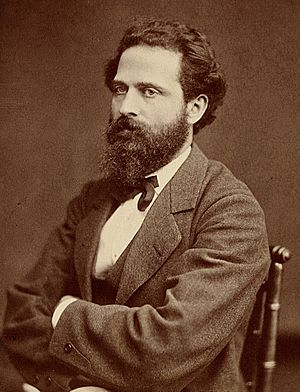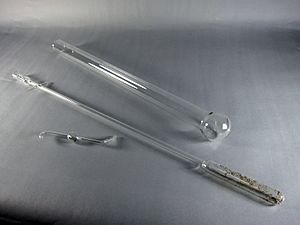Viktor Meyer facts for kids
Quick facts for kids
Viktor Meyer
|
|
|---|---|

Viktor Meyer
|
|
| Born | 8 September 1848 Berlin, Germany
|
| Died | 8 August 1897 (aged 48) Heidelberg, Germany
|
| Alma mater | University of Heidelberg |
| Spouse(s) | Hedwig Davidson |
| Awards | Davy Medal (1891) |
| Scientific career | |
| Institutions | Polytechnikum of Stuttgart, Polytechnikum of Zurich, University of Heidelberg, University of Göttingen |
| Doctoral advisor | Robert Bunsen, Emil Erlenmeyer |
| Doctoral students | Traugott Sandmeyer, Wilhelm Michler, Max Bodenstein, Heinrich Biltz, Jocelyn Field Thorpe |
Viktor Meyer (September 8, 1848 – August 8, 1897) was a German chemist. He made many important discoveries in both organic chemistry (the study of carbon compounds) and inorganic chemistry (the study of other elements).
He is famous for inventing a special machine called the Viktor Meyer apparatus. This machine helps figure out how dense (heavy for its size) a gas is. He also discovered a chemical compound called thiophene, which is a type of heterocyclic compound (a ring-shaped molecule with different kinds of atoms in the ring). Sometimes, his name is spelled Victor Meyer in some of his old writings.
Contents
Early Life and Education
Viktor Meyer was born in Berlin, Germany, in 1848. His father, Jacques Meyer, was a trader and cotton printer. His mother was Bertha. Even though his parents were Jewish, Viktor was not strictly raised in the Jewish faith. Later, he joined a Reform Jewish group. He married a Christian woman, Hedwig Davidson, and they raised their children as Christians.
When he was ten, Viktor went to a gymnasium, which is like a high school. He was very good at science. However, he loved poetry and first wanted to become an actor. His older brother, Richard, was studying chemistry at the University of Heidelberg. When Richard visited, Viktor became very interested in chemistry.
In 1865, before he turned 17, Viktor's parents encouraged him to study chemistry. He started at the University of Berlin. After just one semester, he moved to Heidelberg to work with a famous chemist named Robert Bunsen. He also learned about organic chemistry from Emil Erlenmeyer. Viktor earned his doctorate degree in 1867 when he was only 19 years old. This early start helped him become one of the most important chemists of his time.
Important Work and Discoveries
After getting his degree, Meyer stayed with Robert Bunsen for a year. He helped analyze spring water for the government and taught some students. Later, he joined the group of Adolf von Baeyer in Berlin. Baeyer became one of Meyer's best friends.
When he was 23, Meyer became a professor at the Stuttgart Polytechnic. A year later, he moved to Zurich to teach. He stayed there for thirteen years. During this time, he invented his famous method for finding the density of vapors (gases). He also studied how halogen chemicals could break apart into smaller atoms when heated.
In 1882, Meyer started teaching about benzene chemicals. This led him to discover thiophene, a new chemical compound. In 1885, he became a chemistry professor at Göttingen University. There, he focused on how atoms are arranged in 3D space, a field called stereochemistry. In 1889, his old teacher, Bunsen, retired from the University of Heidelberg. Meyer was chosen to take over his position. He continued his important work until he passed away on August 8, 1897.
Career Highlights
Professional Roles
Viktor Meyer held several important teaching positions during his career:
- 1867: He worked as an assistant in Robert Bunsen's lab. He helped analyze mineral water and prepared students for their exams.
- 1868: He studied organic chemistry at the Gewerbe-Akademie in Berlin with Adolf von Baeyer until 1871.
- 1871: He became a professor of organic chemistry at the Polytechnikum of Stuttgart.
- 1872: He became a full professor at the Polytechnikum of Zurich.
- 1885: He took over the famous chemistry professor position once held by Friedrich Wöhler at the University of Göttingen.
- 1889: He became the head of the chemistry department at the University of Heidelberg, taking over from his former teacher, Robert Bunsen.
Key Scientific Discoveries
Viktor Meyer made many important contributions to chemistry:
- Creating new chemicals: In 1869, he found a way to make aromatic carboxylic acids from other chemicals.
- Nitroalkanes: In 1872, he created nitroalkanes. He used these to tell the difference between different types of alcohols. This is now known as the Victor Meyer test.
- Gas Density Method: In 1878, Meyer developed his famous method for measuring the density of gases. This allowed him to show that mercury, zinc, and cadmium gases are made of single atoms. He also showed that halogen molecules break apart into atoms when heated. The Victor Meyer apparatus helps measure the volume of a gas, which then helps find its density and how heavy its molecules are.
- Glucose Structure: In 1880, he suggested that glucose is an aldehyde and not a ketone. This corrected earlier ideas by other chemists.
- Aldoximes and Ketoximes: In 1882, with Alois Janny, he created aldoximes and ketoximes. This was a new way to figure out the structure of molecules.
- Discovery of Thiophene: In 1882, he found thiophene as an impurity in benzene that came from coal. Benzene made in other ways did not have this impurity.
- Sulfur Mustard: In 1886, he created a reliable way to make pure sulfur mustard, a chemical compound.
- Stereochemistry and Dipole: In 1888, he helped define the ideas of stereochemistry (the 3D arrangement of atoms in molecules) and dipole (a separation of electric charge in a molecule). He was one of the first to teach about these important concepts.
- Iodoso and Iodonium Compounds: In the 1890s, he discovered new types of chemicals called iodoso compounds (1892) and iodonium compounds (1894).
- Victor Meyer Esterification Law: In 1892, he noticed that some benzoic acid chemicals were hard to turn into esters. This observation became known as the Victor Meyer esterification law.
Books Written by Meyer
Meyer wrote several important books about chemistry and even a travel guide:
- Tabellen zur qualitativen Analyse (1884, with Frederick Treadwell)
- Pyrochemische Untersuchungen (1885)
- Die Thiophengruppe (1888)
- Chemische Probleme der Gegenwart (1890)
- Ergebnisse und Ziele der Stereochemischen Forschung (1890)
- Lehrbuch der organischen Chemie (1893, with Paul Jacobson - a very popular textbook) Digital editions
- Märztage im kanarischen Archipel, ein Ferienausflug nach Teneriffa und Las Palmas (1893, a travel guide about the Canary Islands)
Awards and Honors
- In 1891, Viktor Meyer was given the Davy Medal by the Royal Society. This award recognized his amazing experiments and his many contributions to chemistry.
See also
 In Spanish: Viktor Meyer para niños
In Spanish: Viktor Meyer para niños


